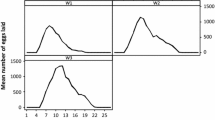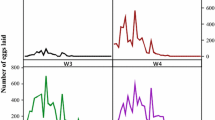Abstract
Ornithodoros rostratus Aragão is an argasid tick found in Bolivia, Paraguay, Argentina and Brazil. Only limited studies about O. rostratus have been conducted and several aspects of their life cycle differ among studies or remain unexplored. In order to better elucidate the biology of O. rostratus, the present work describes its life cycle when feeding on mice under laboratory conditions. To complete their life cycle on mice, O. rostratus goes through a larval stage, 3–6 nymphal instars (nymph 1–6) and adult male and female. Adults can be originated from nymph 3–6. Nymphs 4 with higher weight after feeding tend to originate adults. Adults originated from early instars tended to be lighter. Females tended to be heavier than males. Larvae needed on average 2.7 days to complete their blood meal whereas other instars ranged from 17.3 to 78.3 min. The capacity to ingest blood was higher in larvae and females in comparison to males. The preecdysis period ranged from 5 to 12.5 days. After one blood meal, females remain on average 15.2 ± 5.8 days laying 276.8 ± 137.2.9 eggs. Females originated from nymph 4 had similar oviposition time, egg incubation and conversion ingested blood/number of eggs produced, but presented lower initial weigh and weigh gain, generating fewer eggs. Our results added novel information on O. rostratus biology and was discussed considering the variability of argasid populations and in context with the differences about their life cycle described in previous works.


Similar content being viewed by others
References
Almeida AP, Marcili A, Leite RC, Nieri-Bastos FA, Domingues LN, Martins JR, Labruna MB (2012) Coxiella symbiont in the tick Ornithodoros rostratus (Acari: Argasidae). Ticks Tick Borne Dis 3:203–206. doi:10.1016/j.ttbdis.2012.02.003
Angelakis E, Raoult D (2010) Q Fever. Vet Microbiol 140:297–309. doi:10.1016/j.vetmic.2009.07.016
Aragão H (1936) Ixodidas brasileiros e de alguns países limítrophes. Mem Inst Oswaldo Cruz 31:759–843
Boero JJ (1957) Las Garrapatas de la República Argentina (Acarina: Ixodoidea). Departamento Editorial, Universidad de Buenos Aires, Buenos Aires
Bouchard KR, Wikel SK (2005) Care, maintenance, and experimental infestation of ticks in the laboratory setting. In: Marquardt WC (ed) Biology of disease vectors, 2nd edn. Elsevier, San Diego, pp 705–712
Brumpt E (1915) Biologia de alguns Ixodideos Brasileiros. Ann Paul Med Cir 4:25–29
Cançado PH, Piranda EM, Mourao GM, Faccini JL (2008) Spatial distribution and impact of cattle-raising on ticks in the Pantanal region of Brazil by using the CO(2) tick trap. Parasitol Res 103:371–377. doi:10.1007/s00436-008-0982-8
Estrada-Pena A, Jongejan F (1999) Ticks feeding on humans: a review of records on human-biting Ixodoidea with special reference to pathogen transmission. Exp Appl Acarol 23:685–715
Griffin AT, Espinosa M, Nakamatsu R (2012) Q fever endocarditis: an unusual presentation. Am J Med Sci 344:480–484. doi:10.1097/MAJ.0b013e3182684979
Guglielmone AA, Hadani A (1980) Ciclo biológico de “Ornithodoros rostratus”. Aragao, 1911, bajo condiciones de laboratorio. Rev Med Vet 61:254–257
Guglielmone AA, Estrada-Pena A, Keirans JE, Robbins RG (2003) Ticks (Acari: Ixodida) of the neotropical zoogeographic region. Universiteit Utrecht, J. Bovy-Verbeek (public relations ICTTD), Houten, The Netherlands
Hoogstraal H (1985) Argasid and nuttalliellid ticks as parasites and vectors. Adv Parasitol 24:135–238
Nava S et al (2007) The ticks (Acari: Ixodida: Argasidae, Ixodidae) of Paraguay. Ann Trop Med Parasitol 101:255–270. doi:10.1179/136485907X176319
Ribeiro CC, Faccini JL, Cancado PH, Piranda EM, Barros-Battesti DM, Leite RC (2013) Life cycle of Ornithodoros rostratus (Acari: Argasidae) under experimental conditions and comments on the host-parasite relationship in the Pantanal wetland region, Brazil. Exp Appl Acarol. doi:10.1007/s10493-013-9669-7
Venzal JM, Estrada-Pena A (2006) Larval feeding performance of two Neotropical Ornithodoros ticks (Acari: Argasidae) on reptiles. Exp Appl Acarol 39:315–320. doi:10.1007/s10493-006-9011-8
Venzal JM, Onofrio VC, Barros-Battesti DM, Arzua M (2006) Família Argasidae: características gerais, comentários e chaves para gêneros e espécies. In: Barros-Batestti DM, Arzua M, Bechara GH (eds) Carrapatos de Importância Médico-Veterinária da Região Neotropical. Vox/ICTTD-3/Butantan, São Paulo, pp 13–27
Acknowledgments
We thank Dr M. F. B. Ribeiro (ICB, UFMG) for providing the tick specimens and Dr. P. R. Oliveira (Veterinary School, UFMG) and P. Valente (ICB, UFMG) for the help in the identification of the ticks. The work was supported by Fundação de Amparo à Pesquisa do Estado de Minas Gerais (FAPEMIG), Conselho Nacional de Desenvolvimento Científico e Tecnológico (CNPq), Instituto Nacional de Ciência e Tecnologia em Entomologia Molecular (INCT-EM) and Pro-reitoria de Pesquisa (PRPq) da UFMG through the Programa Institucional de Auxílio à Pesquisa de Doutores Recém-Contratados.
Conflict of interest
Authors declare they have no conflict of interest.
Author information
Authors and Affiliations
Corresponding author
Rights and permissions
About this article
Cite this article
Costa, G.C.A., Soares, A.C., Pereira, M.H. et al. Life cycle of Ornithodoros rostratus (Acari: Argasidae) ticks feeding on mice under laboratory conditions. Exp Appl Acarol 66, 53–61 (2015). https://doi.org/10.1007/s10493-015-9888-1
Received:
Accepted:
Published:
Issue Date:
DOI: https://doi.org/10.1007/s10493-015-9888-1




